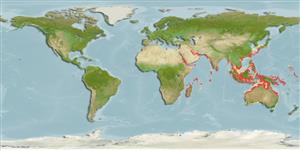Common names from other countries
Environment: milieu / climate zone / depth range / distribution range
Écologie
; saumâtre, usually 0 - 25 m (Ref. 75831). Tropical
Distribution
Pays | Zones FAO | Écosystèmes | Occurrences | Introductions
Indo-West Pacific: Reported from East Africa, including South Africa and the Red Sea, to southern Japan, the Philippines, and eastern Indonesia.
Length at first maturity / Taille / Poids / Âge
Maturity: Lm ? range ? - ? cm Max length : 6.0 cm SHL mâle / non sexé; (Ref. 348); common length : 5.0 cm SHL mâle / non sexé; (Ref. 348)
The distribution of this species is imperfectly known because of frequent confusion with other species of the genus (Ref. 348). Found in intertidal areas, in mud and sand, (Ref. 75831) and shallow sublittoral waters (Ref. 348). In sheltered bays and estuaries (Ref. 348).
Life cycle and mating behavior
Maturité | Reproduction | Frai | Œufs | Fécondité | Larves
Members of the class Bivalvia are mostly gonochoric, some are protandric hermaphrodites. Life cycle: Embryos develop into free-swimming trocophore larvae, succeeded by the bivalve veliger, resembling a miniature clam.
Poutiers, J.M. 1998. (Ref. 348)
Statut dans la liste rouge de l'IUCN (Ref. 130435)
statut CITES (Ref. 108899)
Not Evaluated
Not Evaluated
Menace pour l'homme
Harmless
Utilisations par l'homme
| FishSource |
Outils
Plus d'informations
Taille/Âge
Croissance
Longueur-poids
Longueur-longueur
Morphologie
Larves
Abondance
Sources Internet
Estimates based on models
Preferred temperature
(Ref.
115969): 24.1 - 29.2, mean 28.2 (based on 1694 cells).
Vulnérabilité
Low vulnerability (10 of 100).
